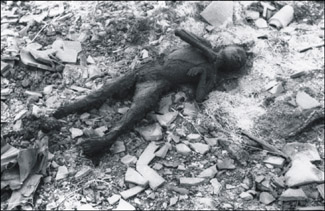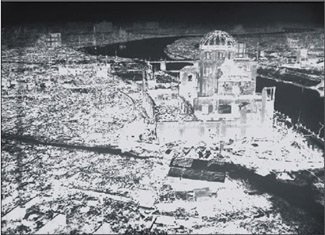Chapter 3
Nuclear Nightmare
“Brighter than a thousand suns, now I am become Death,
the destroyer of worlds.”
—Robert Oppenheimer, Director of the Manhattan Project,
upon the explosion of the first nuclear weapon. Quoting Hindu scripture, Bhagavad Gita
My research indicates that over one billion people have been killed in war over the past 5,000 years. The evolution of weaponry from rocks and clubs to weapons of mass destruction (WMDs) makes it now possible to kill more people in a single day than have been killed in all of the armed conflicts that have occurred throughout recorded history. WMDs pose a clear and present danger of annihilating humanity. (see Appendix B)
Several nations possess WMDs (nuclear, biological, and chemical weapons), creating a world where the extinction of life can occur with swift, extensive, and horrendous consequences. A target is virtually defenseless against a WMD after it has been unleashed. The grim realization that an effective defense from a nuclear attack was not achievable led to the strategy of mutual assured destruction ("MAD") as the only deterrent to nuclear conflict. Nations have come to the conclusion that the best deterrent to being attacked is to instill the fear in a potential attacker that it will suffer a disproportionate response. Under this rationale, the best defense is a strong offense. Therefore, nations believe that they must have more weapons than other nations, resulting in WMD proliferation. Despite efforts to eliminate WMDs, 26,000 of them still exist. Based on conventional techniques of control, we can expect more will be created.
Nuclear weapons destroy life and property in several ways: the initial blast, a fire storm, an electromagnetic pulse, thermal radiation, radioactive fallout, and climatic disruption. Their effects are long lasting.
The shock wave from a 1 megaton bomb will only dissipate from over 1,000,000 psi (pounds per square inch) at the epicenter to about 500 psi when it reaches ½ mile away. It will pulverize concrete and brick structures. However, 500 psi is like being pinned under 15 cars. It is the atmospheric pressure on the hull of a typical submarine at its crush depth, about 1,000 feet below sea level.
The blast pressure creates 300 to 500 mph winds that send human missiles through the air at the speed of a commercial jet, 2 to 3 times that of a Category 5 hurricane. The force rapidly expands outward, and the pressure at the hypocenter immediately drops from high to low or negative, creating a vacuum effect. The negative pressure is so strong that in Hiroshima, eyeballs were sucked from eye sockets in people 1/3rd of a mile away. The blast splinters glass into tiny shards, blown by the winds with such force that they become embedded in peoples’ bodies. Moments later the wind rushes back into the low pressure area causing more damage. (For an explanation of how nuclear weapons generate such enormous energy, see Appendix C)

Charred remains of a boy, apparently gasping for air. Nagasaki, early afternoon, August 10, 1945. Photographer Yosuke Yamahata. © Shogo Yamahata. Japan Peace Museum
A blast of heat follows 1/10th of a second later from the thermal energy being released. A 1 megaton bomb produces 10,000,000° C at the blast site. The heat slowly dissipates to 5,000° C as it reaches a 4 mile radius and 100° C as it reaches 10 miles away. In contrast, a conventional bomb only produces 5,000° C, and that heat dissipates entirely within 1/10th of a mile. Since the majority of the human body is composed of water, the intense heat of a nuclear bomb instantly vaporizes people within a 3 mile radius. Their bodily fluids evaporate, and the remaining solid tissues (bones, organs, and muscles) leave an unidentifiable residue of carbon and ash before the electrical signals from their nerves reach their brains. Shadows of people close to ground zero are formed on concrete structures behind them.

The Hiroshima Prefectural Industrial Promotion Hall was reduced to rubble. Located close to the hypocenter, the building received the blast from almost directly above, which allowed some of the center walls to escape collapse. The steel skeleton of the dome became a symbolic landmark, the A-bomb Dome. Negative image of photo by US Army Courtesy of Hiroshima Peace Memorial Museum.
A nuclear detonation releases a short intense burst of gamma rays that create an electromagnetic pulse (EMP) of thousands of volts. The EMP from just one bomb can disable the power grid for a large section of a nation. Electrical conductors such as wires, antennas, and other metal objects will be severely damaged. The EMP will irreparably damage micro circuits, which are increasingly used in everyday equipment such as cell phones, computers, pacemakers, and navigational equipment on airplanes.
Psychiatrist Robert Jay Lifton, Professor at Harvard Medical School and Cambridge Hospital, interviewed survivors of the first atomic bomb. Read the testimonies of just two people from his book, Death in Life: Survivors of Hiroshima:
…they all had skin blackened by burns…at a glance you couldn’t tell if you were looking at them from in front or in back…and their skin—not only on their hands, but on their faces and bodies too—hung down. They had a special way of walking—very slowly…I myself was one of them.
—Hiroshima grocer.[1]
The explosion sends mud and dust into the atmosphere. Soot from the fires combining with the mud and dust particles precipitate large droplets of contaminated black rain. The initial gamma ray burst causes acute death. Radiation alone from the smaller Hiroshima bomb killed half of the people within three square miles. Depending on the amount of radiation exposure, unlucky survivors of the initial blast develop mouth ulcers and purple spots on their skin from blood leaking out of their cells as their body’s molecular structure breaks down. They suffer nausea, diarrhea, anemia, and internal bleeding as well as bleeding from the gums and from bodily orifices. Their hair falls out in clumps. Loss of white blood cells and antibodies lower their body’s resistance to infection, and they can die from otherwise harmless infections.
I had the sensation that my whole body had been split…
But I didn’t know what had happened, and everything seemed strange. I touched my face and the skin stuck to my finger. That frightened me. And when I touched my nose, I had no sensation of my nose but my finger felt something swollen and hot.
After three months, however, when she began to feel stronger and wanted to see what she looked like, she discovered that her parents were trying to prevent her from doing so.
But whenever I asked them for a mirror, they would say that they did not have one in the house… [2]
—Mi-chan, hospital worker
Survivors either die painfully over the next few weeks or prematurely from genetic damage leading to cancer and leukemia. Many endure the remainder of their life with grotesque deformities. Unborn children, including those not yet conceived will have birth defects such as microcephaly (an abnormally small head), spina bifida, cleft palate, and blindness.
The prevailing winds will carry the radioactive fallout away from the blast site. A cold, dark, radioactive twilight of gloom (Carl Sagan’s “nuclear winter”) will envelope the Earth. It will last for months, perhaps for years. The atmosphere will be overcast from tons of suspended fine radioactive dust and soot that absorb sunlight, and cause severe climatic disturbances. Temperatures will drop below freezing for months.
Depending on the amount of fallout deposited, distant populations and their food and water supplies will be poisoned for decades. Soil around ground zero is radioactive for years, making it unsafe to return there. Although the half-life (the time it takes for half of the atoms to decay into other elements) of a few radioisotopes is short (Yttrium-90 is 2 days), most remain radioactive so long that it is difficult to comprehend. The half-life of Uranium-235 is 704 million years. It will take from 6 to 7 half-lives for a radioactive isotope to decay to 1% of its original amount.
The photosynthesis process, by which plants produce oxygen, will be impaired, crops and farm animals destroyed, and many species of plants and animals extinguished. Medical facilities and drugs will be unavailable. The absence of medical care and the decline in sanitation measures can lead to rampant disease, psychiatric disorders, epidemics and pandemics. Severe depression will result in suicides. There will be no electricity to run appliances or to light homes, gas for heating, fuel for transportation, or communications. Police protection and other government services will be scarce. Widespread food and drinking water shortages and resources in general will not support the surviving population.
[1]Robert J. Lifton, Death in Life: Survivors of Hiroshima, (London: Weidenfeld & Nicolson, 1967): 27.
[2]Robert Jay Lifton, Death in Life: Survivors of Hiroshima: 175.